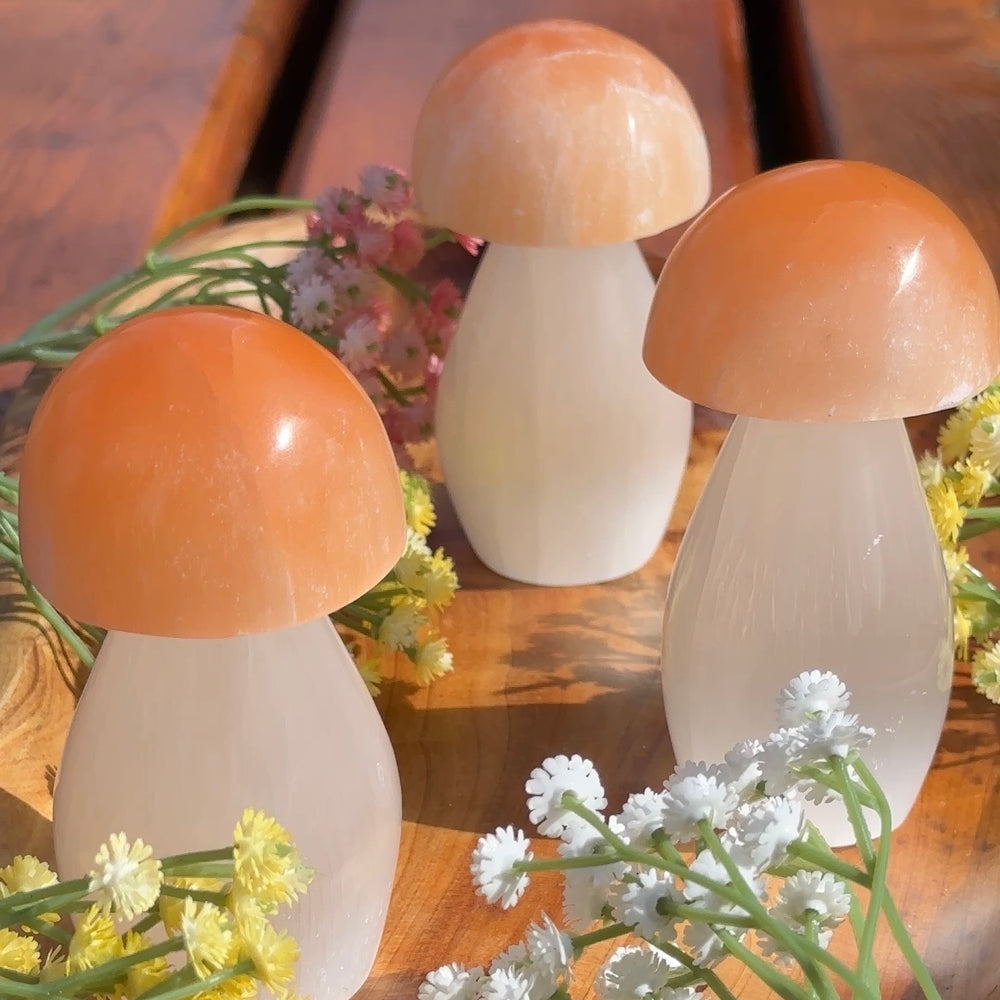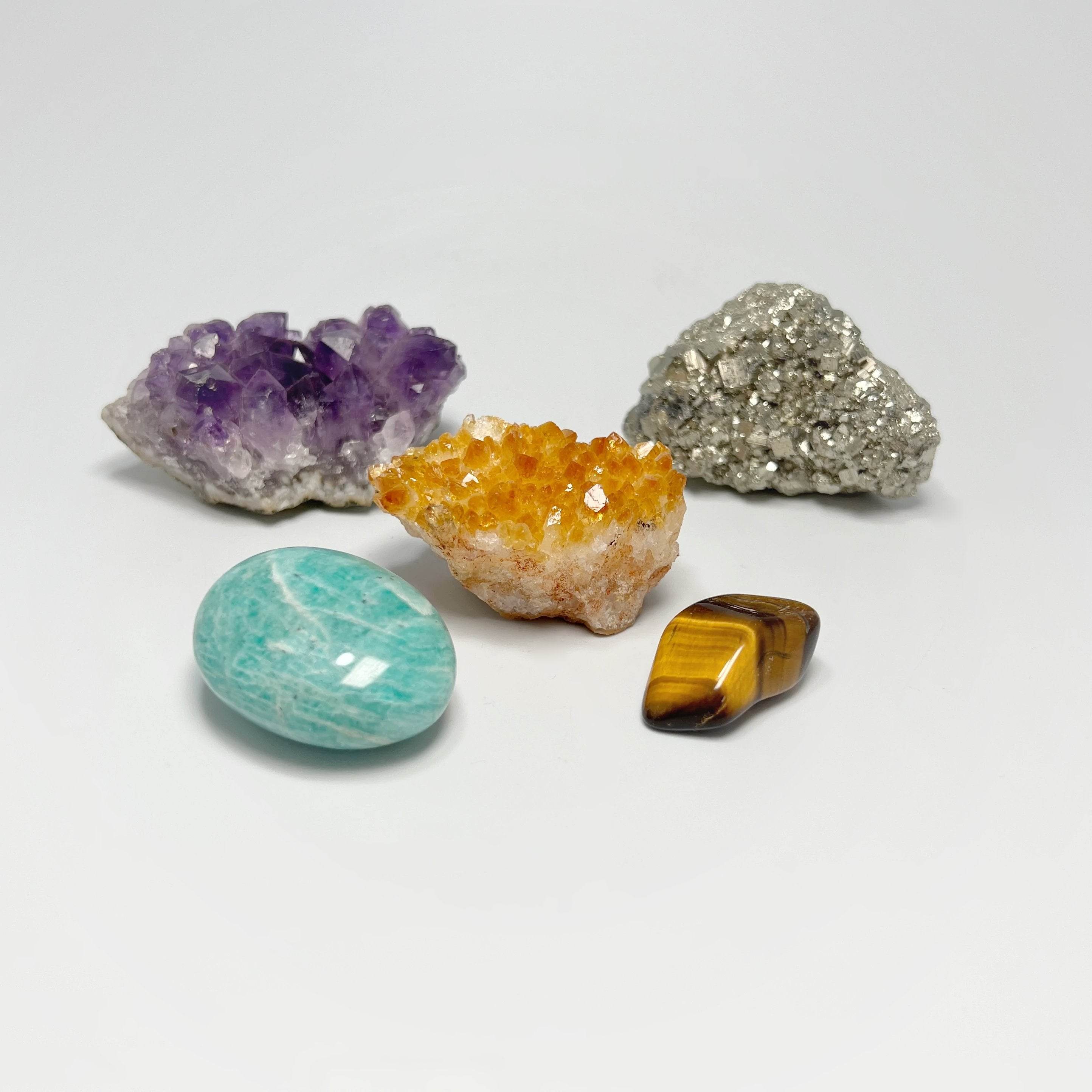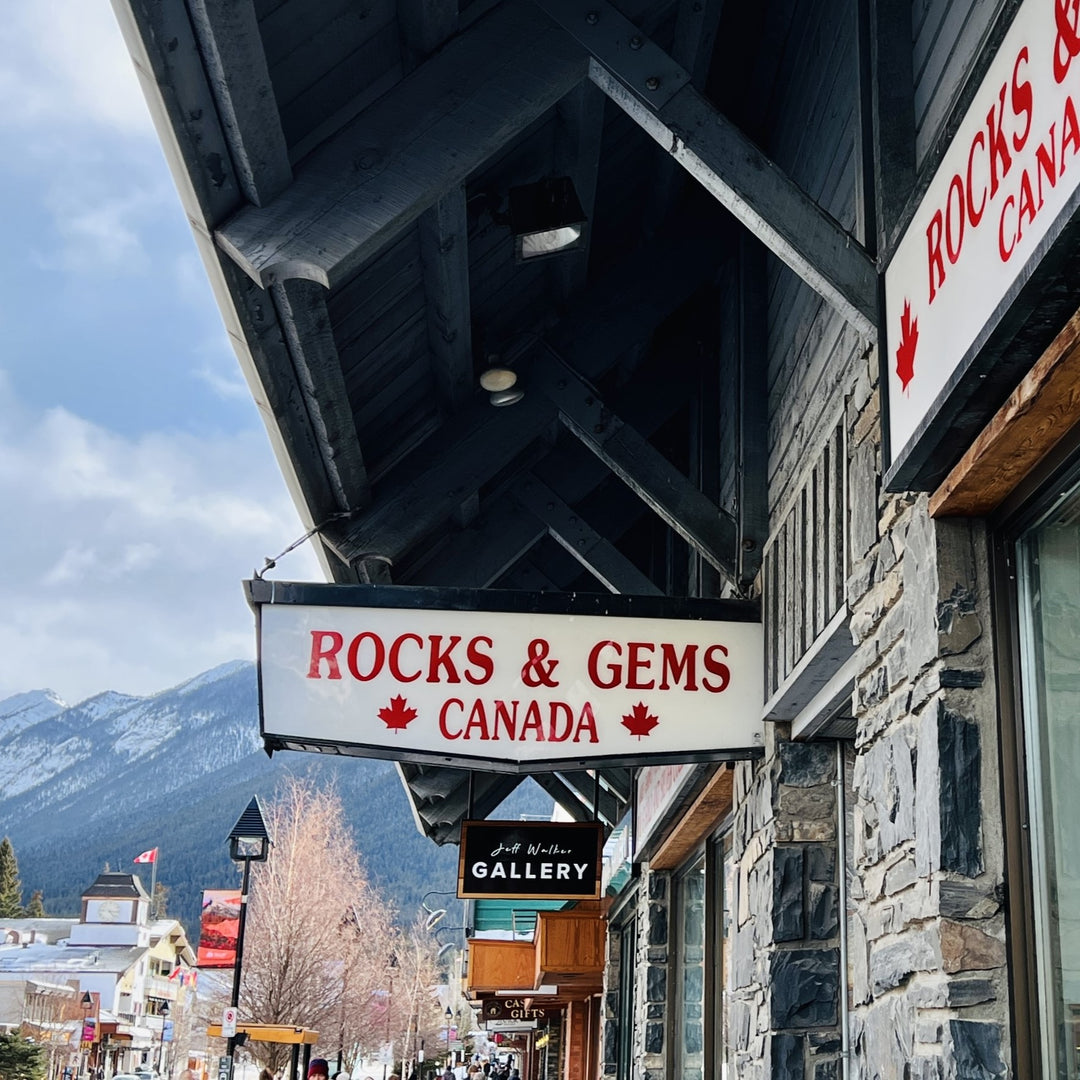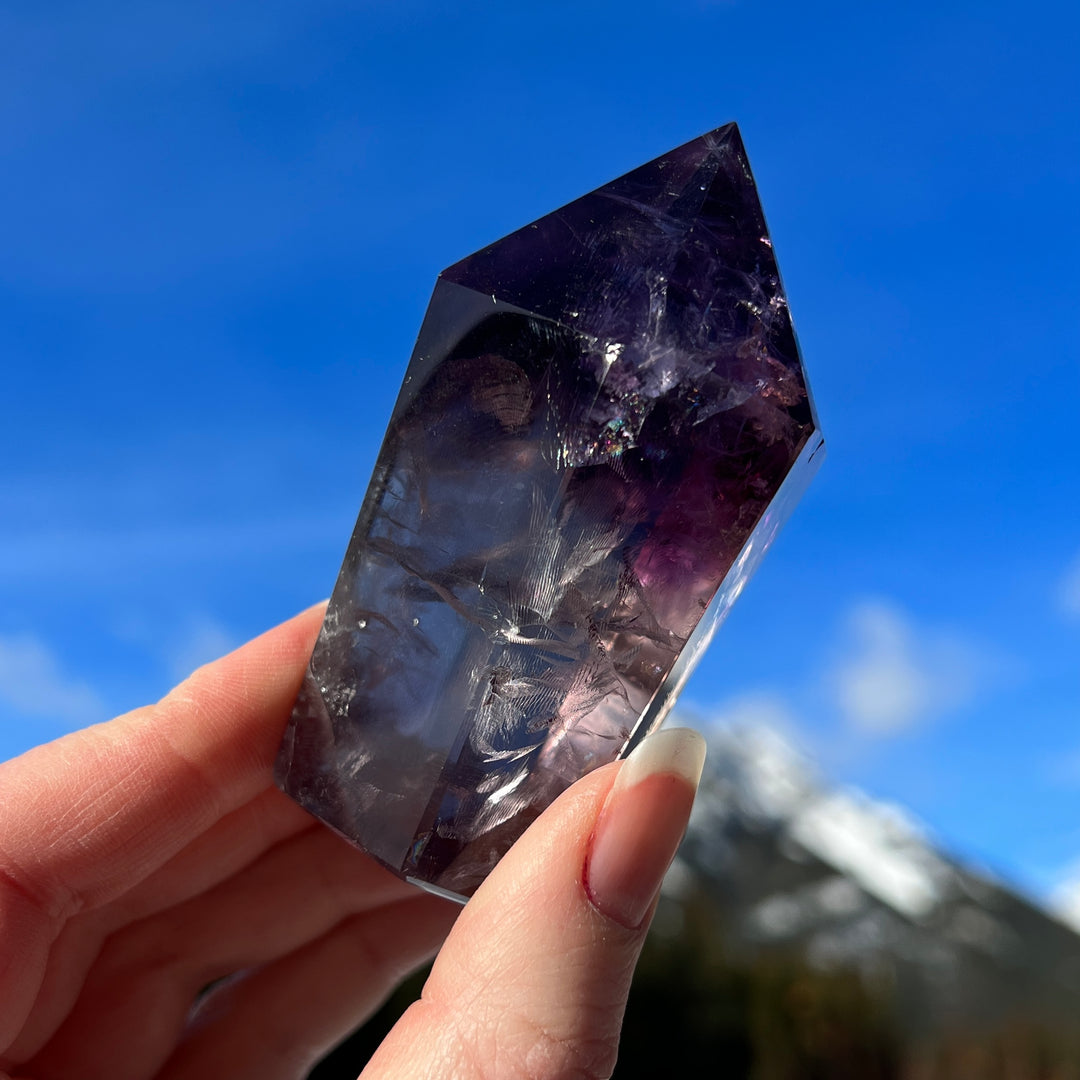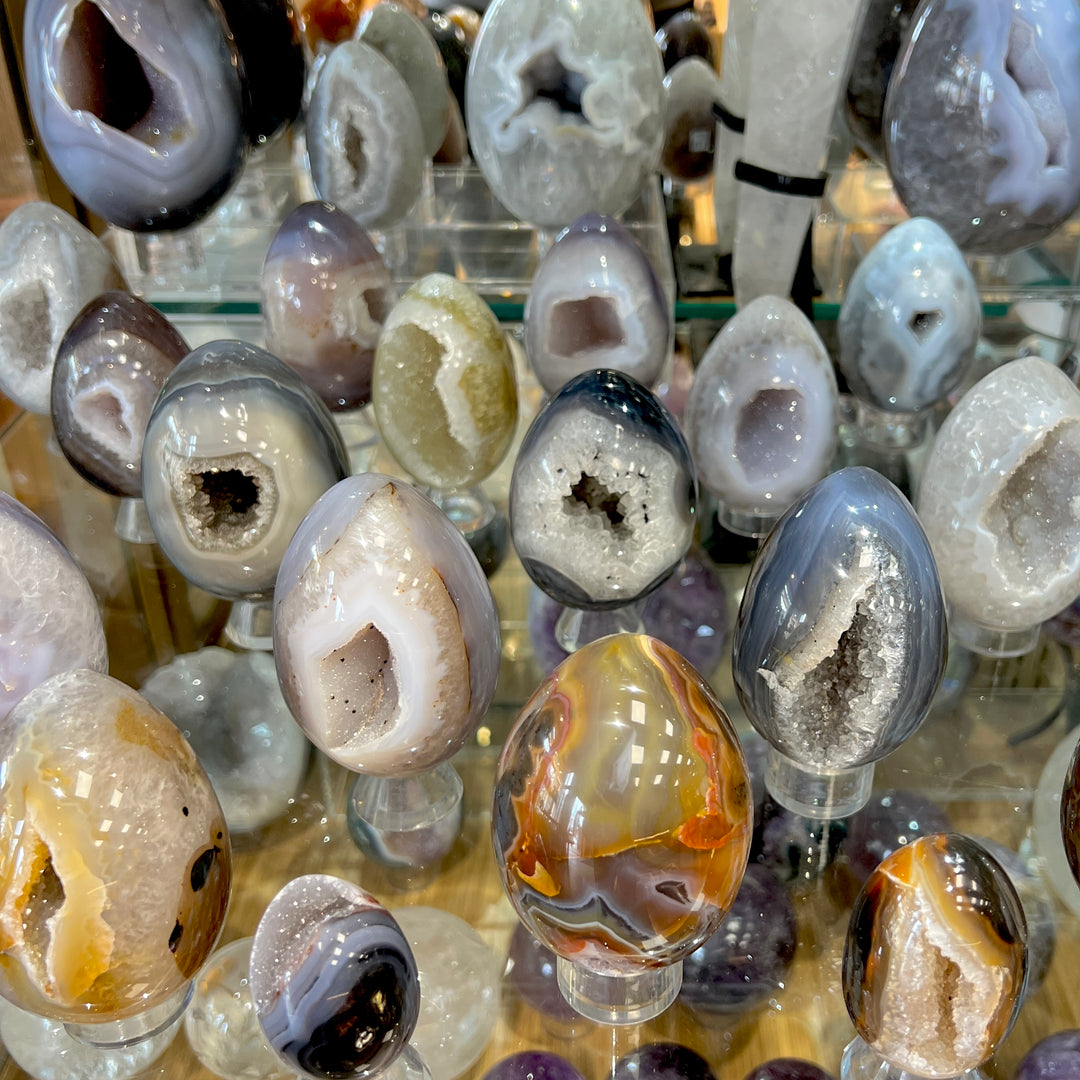Our gemstone mushrooms provides a sense of connection with the earth's energy representing growth, balance, harmony. The grounding energy make them a perfect addition to any room or meditation space.
Amethyst / Chevron Amethyst:
A favorite material of ancient cultures, amethyst has endured the ages as one of man's most prized possessions. Amethyst ranges in color from a very light lavender to a deep violet shade of purple sometimes with slight hues of pink and red. Banded amethyst or cape amethyst may have lines of agate or chalcedony running through the amethyst. This may also be called chevron amethyst. Amethyst is found worldwide and has the distinction of being the birthstone for February and the official gemstone of the province of Ontario.
Aventurine:
Green Aventurine carries a strong relationship to Earth and can help better appreciation of nature. It also helps stimulate growth of children and may enhance cognitive abilities of children struggling in school. It is also ideal for calming quick-tempers and encouraging love.
Opalite:
Opalite, also known as sea opal or opalized glass, is a man-made synthetic glass resin designed to mimic the appearance of opal gemstones. While it doesn't possess the same geological composition or properties as natural opal, it's still valued for its unique appearance and metaphysical properties.
Carnelian Agate:
Carnelian Agate ranges in color from orange/red to rust and brown. It can be solid in color or on occasion it will be banded with white or other colors to produce very unique patterns. Expert gem cutters carefully select the rock and cut to produce the stones with the best color patterns. The stone can be found in several Canadian locations including near Lake Superior, British Columbia and others as well as several locations worldwide including Brazil and Africa.
Purple Agate:
Agate is a relatively common stone that may be found around the world. Agate is a member of the chalcedony/ quartz family of stones. Agates are believed to have been formed millions of years ago during volcanic eruptions. The volcanic lava flows left cavities filled with gas. As the flows cooled, these cavities allowed for mineral bearing solutions to enter and the combinations of these solutions along with heat, pressure and millions of years allowed the agate to form.
Tree Agate:
Tree agate is a beautiful and intriguing variety of agate, a type of chalcedony known for its unique banding patterns and colors. Tree agate, in particular, is distinguished by its mossy or dendritic inclusions that resemble tree branches or foliage. Tree Agate is the common name for Dendritic Agate. Place one of these anywhere that you want to encourage abundance and fullness. Tree Agate can help to create a peaceful environment, deepening your connection to the earth.
Blue Howlite:
Howlite is a semi-precious stone first found in Nova Scotia, Canada. It was named after Henry How, the Canadian mineralogist that first discovered it. It is usually a white stone found with black-grey lines running through it. It is found in nodule formation, much like a white colored turquoise. Howlite is a soft and porous stone. Gemstone cutters will select howlite with white lines and patterns on it, as no two pieces are exactly alike. It is a great stone for jewellery and stone carvings.
Lapis Lazuli:
Lapis lazuli is one of the most prized semi-precious stones. It has been used throughout the centuries for many purposes. Some believe that Cleopatra used crushed lapis as an eye shadow, while later in Italy it was crushed and used as a tint in expensive oil paints. The eyes of the Sphinx were said to be made of lapis discs before the Romans took them out long ago. Lapis may have iron pyrite, or fool's gold, running through it, or it may be found with a white mineral called calcite. Good lapis is a rich blue color and is becoming more difficult to get.
Tiger Eye:
Tiger eye or tigers eye is a member of the quartz family of stones. It is a brownish-gold gemstone to a reddish gold gemstone that may produce a chatoyancy or flash when it is turned in the light. This flash is said to resemble the "eye's of a tiger" and thus that is where the name comes from. It also will come in purely red and blue colors, although more rarely. Sometimes the gold brown variation is called hawks eye.
Bloodstone:
Bloodstone, also known as heliotrope, is closely related to the quartz and jasper families of stones and is often referred to as a type of jasper. The most common bloodstone is a dark green colour with splashes or speckles of red running through it.
Sodalite:
Sodalite is one of the lesser-known Canadian gemstones. It occurs in many locations throughout Canada, including near Bancroft, Ontario, in the Ice River Valley, and Kicking Horse River areas of British Columbia. Sodalite is usually found in a massive formation, and occurs in white, blue, violet and pink colors. Whether your sodalite is solid blue or mixed with other colors, it is sure to be a stone of great beauty and character.
Obsidian:
Obsidian is a form of volcanic glass, it has been used as glass by ancient cultures. Some call it smoky tears or Apache Tears, as it is said to resemble a tear when held up to the light.
Mudline Jasper:
Jasper is a family of stones that comes in many different varieties and colours. With over 2000 known varieties, the Jasper family of stones continues to grow and diversify with each new discovery. Jasper may be found in many countries of the world including Canada. Mudline may make you more insightful, and assist you in balancing your masculine and feminine energies.
Labradorite:
Labradorite is a Canadian gemstone that comes from several places in Newfoundland, including Tabor Island, Cornerbrook, and various parts of Labrador. It has also been found in the Canadian North West Territories and Nunavut. It is sometimes used by the Inuit people of Canada’s north but not often, as it is a hard stone to work with. It is a chatoyant stone (colors flash on different angles), usually blue and green with pinks, yellows, purples, and other colors on occasion. Good labradorite will have a bright flash or play of colors when turned different angles.
Jade:
Canadian jade is a type of nephrite jade that ranges in color from light green to dark green and sometimes in a black. The jade is found all over British Columbia, including Cassiar, Dease Lake, Hazelton and sometimes in the Frazer and Bridge Rivers, to name a few. The Canadian jade mines are the largest jade producing mines in the world. As many Canadian mines are slowly being depleted, the price of jade keeps going up as it becomes scarcer.
Blue / Orange Calcite:
Calcite is a form of calcium carbonate. It is a fairly common component found in limestone. It is a fairly soft stone, it is a 3 on the Moh’s scale which makes it fairly easy to carve and cut. It is sometimes transparent or translucent. It can be found in several different colors including blue, green, orange, white, pink, and others. It is a beautiful stone, often used in home decorator pieces.
Quartz / Strawberry Quartz:
The quartz stone family is extremely large and varied. Some of the more famous members include amethyst (purple quartz), citrine(yellow quartz), smoky quartz (black), rutilated quartz (quartzes with other minerals growing inside them), as well as all the various agates and jaspers. Quartz may be found worldwide including many Canadian locations.
Unakite:
Unikate is a form of epidote feldspar that is a beautiful mixture of pink and green. This colour combination produces attractive patterns in the stone. No two pieces look alike which is part of the beauty of this unusual stone. Green rose jasper is very similar looking to unikate, with the exception that there is more pink colouring and less green in the stone. Seashell jaspers are mostly pink or peach in colour.
Larvikite:
Larvikite is a member of the Feldspar family. The name originates from the Larvik Fjord region in Norway, where this type of igneous rock is found. It is sometimes called "Black Moonstone" and even "Labradorite", more likely because they are all Feldspar minerals.
Howlite:
Howlite is a semi-precious stone first found in Nova Scotia, Canada. It was named after Henry How, the Canadian mineralogist that first discovered it. It is usually a white stone found with black-grey lines running through it. It is found in nodule formation, much like a white colored turquoise. Howlite is a soft and porous stone and this makes it easy to dye other colors such as light and dark blue. Gemstone cutters will select howlite with white lines and patterns on it, as no two pieces are exactly alike. It is a great stone for jewellery and stone carvings.
Kambaba Jasper:
Jasper is believed by some to strengthen as well as heal the physical body. Various green jaspers may also help with intellectual pursuits, as it allows you to be calm and may help with the immune system. Whatever your beliefs, may you enjoy your unusual piece of jasper.
Luminous Stone:
Luminous glow stone is a unique type of glass that glows in the dark! For best results, expose your luminous glow stone in direct light throughout the day, and watch it glow at night. Humans have made glass for centuries, and each generation finds new ways to enhance glass with new innovations. Luminous glow stone is one such enhancement, where a photoluminescent powder is added to molten glass during its production. Made of safe, non-toxic materials, these glowing pigments create a vivid product for all to enjoy.
These carvings are authentic stones, and no two are exactly alike. The item you receive may have slight variations from the one photographed. Please note, Purple Agate and Blue Howlite are dyed to achieve the colouring.














